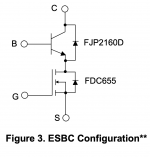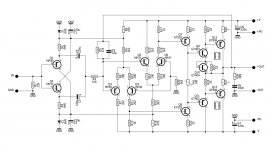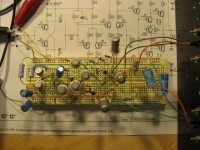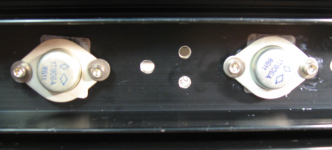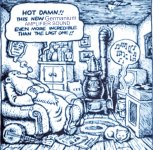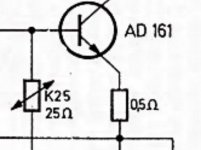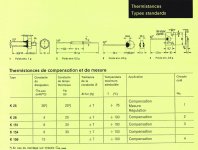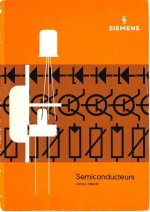I am happy to see the varied contributions here. Fun topic.
My day job has me on a sequestered project until mid September so not much time for hobby pursuits.
I have acquired a wide variety of small and larger signal Germanium devices. Running the curve tracer, I have yet to find a Germanium device with the nasty quasi-sat behavior that I saw in KSC3503. The quasi sat region of the Ge devices show a smooth quasi sat knee region.
My day job has me on a sequestered project until mid September so not much time for hobby pursuits.
I have acquired a wide variety of small and larger signal Germanium devices. Running the curve tracer, I have yet to find a Germanium device with the nasty quasi-sat behavior that I saw in KSC3503. The quasi sat region of the Ge devices show a smooth quasi sat knee region.
Me too. The parts have yet to make a suggestion.

And, has a decision already been reached by the parts,
or does it take a some more time to hatch?
Less complexity promotes a decision:
something tube-like perhaps...
Got my TO-36 Germanium devices in the mail a few days ago. The locating pins have an insulating plastic sleeve over them to help isolate the case from the heat sink. I'm also the proud owner of 100 mounting kits including mica insulators, shoulder washers, nuts, etc. - cheap on E-prey.
The parts haven't spoken to me above a whisper just yet. I keep on getting notions to add frills to the design to offset the concerns of bias stability and limited current gain, as I tend to shy away from designs that require a hefty preamp in order just to drive them. This probably flies in the face of the general NP notion of putting together a simple amp that lets the unique characteristics of the part sing forth - I'm stubborn that way..
The parts haven't spoken to me above a whisper just yet. I keep on getting notions to add frills to the design to offset the concerns of bias stability and limited current gain, as I tend to shy away from designs that require a hefty preamp in order just to drive them. This probably flies in the face of the general NP notion of putting together a simple amp that lets the unique characteristics of the part sing forth - I'm stubborn that way..
The parts actually sang to me a couple of hours ago, and I'm going to go with a design that incorporate Germanium devices in a Darlington config, with diff front end, and active loading. It won't be the most efficient beast around (what Class A design is?), but it should make some noise. More (much) later, as my Aleph headphone amp will be usurping most of my free time.
Little Ge Power Amp
Here is a little Ge power amp using Soviet (mostly) Germanium transistors. The schematic was suggested back in 2005 by WP@forum.vegalab.ru (in Russian), I just added a Baxandall diode (Q10) to improve the output stage's symmetry.
The transistors are:
With +/-15V supplies, it can deliver 8-9Vrms before (soft and nice) clipping. The supply voltage can be increase to +/-18V, but since the drivers are only rated at 40V, a regulated power supply would be a good idea.
Also, the amplifier quickly runs away thermally, as I didn't have a suitable thermistor at hand, so a current limited power supply saves the day. Stability/compensation needs to be revised once it is off that solderless breadboard.
Here is a little Ge power amp using Soviet (mostly) Germanium transistors. The schematic was suggested back in 2005 by WP@forum.vegalab.ru (in Russian), I just added a Baxandall diode (Q10) to improve the output stage's symmetry.
The transistors are:
- MP37A and MP40A - small signal NPN and PNP, respectively, rated at 30V, 20mA, 150mW, fT 1MHz (common emitter), hFE 15..30
- GT402G and GT402G - medium power NPN and PNP, 40V, 0.5A, 0.6W, 1MHz, hFE 60..150
- GT906A - power PNP, 75V, 6A, 15W, 30MHz, hFE 60..150
- KT502/503 - small signal silicon transistors
With +/-15V supplies, it can deliver 8-9Vrms before (soft and nice) clipping. The supply voltage can be increase to +/-18V, but since the drivers are only rated at 40V, a regulated power supply would be a good idea.
Also, the amplifier quickly runs away thermally, as I didn't have a suitable thermistor at hand, so a current limited power supply saves the day. Stability/compensation needs to be revised once it is off that solderless breadboard.
Attachments
No Germanium designer would use 13 transistors for 8 Watts. 20W-80W with 4 or 5 devices was par.
> I didn't have a suitable thermistor at hand
You could use Ge diodes. Which can be half-dead Ge transistors. But now we approach 17 devices.
I have every faith that your project works. Just saying it isn't historically typical. A lot of audio improvement is not from Si but from increased production (computers) driving down costs.
> I didn't have a suitable thermistor at hand
You could use Ge diodes. Which can be half-dead Ge transistors. But now we approach 17 devices.
I have every faith that your project works. Just saying it isn't historically typical. A lot of audio improvement is not from Si but from increased production (computers) driving down costs.
Totally agree! Sixties style amps were using the absolute minimum of (expensive) active devices. No current sources, no current mirrors, no LTPs, no diamond buffers, no dual NPN/PNP followers, and certainly no RF power transistors in the output stage. These days, even those old Ge parts are cheap, so one can explore completely different topologies.No Germanium designer would use 13 transistors for 8 Watts. 20W-80W with 4 or 5 devices was par.
it isn't historically typical.
Hi G-lovers. I have found (by accident) a supplier of old school electronics at local ebay-type website. That means Ge transistors, diodes. (and a lot of other ancient part, cables, etc. mostly military grade)
Interested?
Now he has OC1071, ASY37F, ACY20, 2n1183, ac176, OC29, ad148, asy34... and many others.
Przedmioty użytkownika half_century_ago - Tranzystory - Allegro.pl
Interested?
Now he has OC1071, ASY37F, ACY20, 2n1183, ac176, OC29, ad148, asy34... and many others.
Przedmioty użytkownika half_century_ago - Tranzystory - Allegro.pl
A lot of audio improvement is not from Si but from increased production (computers) driving down costs.
Much of the cost reduction came from improved manufacturing processes and statistical process control. This drove up the yields from abysmal 40 something percent (or worse) to 90+. Price and availability is unstable when you throw more than half of your product in the trash and every batch is different.
Where do you think the failed parts went?
For those of us old enough to remember..….Poly Paks…...no time to test em!
Many also wound up in blister packs at Radio Shack, Olson's and Lafayette.
The same thing happened with vacuum tubes. When GE ran a batch of tubes, several samples were selected from the batch and subjected to an Accelerated Life Test. If a certain number of failures occurred the entire batch was rejected and sold unbranded in bulk to the rebranders. Names like Best Test, Thoro Test, and Standard Brand would put their label on the tubes, and maybe retest them. I can remember saving my money as a kit to buy a pair of Thoro Test 6L6GC's from an Army-Navy surplus store near my house for $0.99 each in the 1960's. It took me several years to kill them.
Do you have any suggestions for a topology for the 2SB206? Your insight would be very welcomed in this thread.
Much of the cost reduction came from improved manufacturing processes and statistical process control. This drove up the yields from abysmal 40 something percent (or worse) to 90+. Price and availability is unstable when you throw more than half of your product in the trash and every batch is different.
Where do you think the failed parts went?
For those of us old enough to remember..….Poly Paks…...no time to test em!
Many also wound up in blister packs at Radio Shack, Olson's and Lafayette.
The same thing happened with vacuum tubes. When GE ran a batch of tubes, several samples were selected from the batch and subjected to an Accelerated Life Test. If a certain number of failures occurred the entire batch was rejected and sold unbranded in bulk to the rebranders. Names like Best Test, Thoro Test, and Standard Brand would put their label on the tubes, and maybe retest them. I can remember saving my money as a kit to buy a pair of Thoro Test 6L6GC's from an Army-Navy surplus store near my house for $0.99 each in the 1960's. It took me several years to kill them.
No insight of any value, probably.
All of my germanium experiments centered around what I could get for free or real cheap as a teenage kid in the 60's. Most used the classic totem pole design that I showed in post #56. This required winding your own driver transformer, or buying one at the local Heathkit store. These designs were good in the day, but would be useful today only for a "period correct" amp.
I got a job at Motorola in late 1972. Silicon was free just by filling out a sample request form, so from 1973 on all my amps were silicon based, and again used the designs common in the 70's and early 80's. For a nearly 20 year period I built computer and ham radio stuff. Sound came from Phase Linear and Carver....until an old tube amp kicked that stuff into the closet. From the late 90's on most of my builds have been tube or hybrid designs.
I still have a few germanium small signal parts left, but they go into period correct (60's) guitar pedals.
I did spend a good deal of my career at Motorola learning about Statistical Process Controls. We made two way radios and cell phones, and went through the same manufacturing cultural changes as the semiconductor industry. We even had people living in and commuting to Japan to learn how they evolved technically.
All of my germanium experiments centered around what I could get for free or real cheap as a teenage kid in the 60's. Most used the classic totem pole design that I showed in post #56. This required winding your own driver transformer, or buying one at the local Heathkit store. These designs were good in the day, but would be useful today only for a "period correct" amp.
I got a job at Motorola in late 1972. Silicon was free just by filling out a sample request form, so from 1973 on all my amps were silicon based, and again used the designs common in the 70's and early 80's. For a nearly 20 year period I built computer and ham radio stuff. Sound came from Phase Linear and Carver....until an old tube amp kicked that stuff into the closet. From the late 90's on most of my builds have been tube or hybrid designs.
I still have a few germanium small signal parts left, but they go into period correct (60's) guitar pedals.
I did spend a good deal of my career at Motorola learning about Statistical Process Controls. We made two way radios and cell phones, and went through the same manufacturing cultural changes as the semiconductor industry. We even had people living in and commuting to Japan to learn how they evolved technically.
Last edited:
Much of the cost reduction came from improved manufacturing processes and statistical process control. This drove up the yields...
It was of course a multi-faceted progression.
TI had a government contract to drive-down the cost with touchless assembly line, a massive investment. All us old guys remember the odd epoxy package on Flickenger and other early audio opamp cards, other pro dome-top gear.
Motorola and others devised even cheaper plastic packages.
Power Planar was a step backward in SOA but miles ahead in yield, consistent performance, and cost compared to RCA's baked-potato 2N3055.
Andy Grove and others refined dopant control and surface states.
Of course the "statistical controls" may have benefited from the falling cost of computing to chew mass data several ways.
..just send few of Ge biggies to Mr. MR..
Does MR need GE's?
I will happily send some..
We have new messages about great future germanium investigators!
Welcome to the club Hahaha
Attachments
GE schematics flashback
Attachments
-
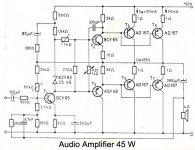 FB703610-C6E2-48C0-A6E1-3563464D136A.JPG84.3 KB · Views: 327
FB703610-C6E2-48C0-A6E1-3563464D136A.JPG84.3 KB · Views: 327 -
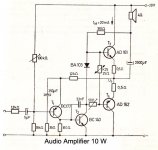 4EFA395C-9C61-43E1-90F4-404D2BD4EF38.JPG94.7 KB · Views: 650
4EFA395C-9C61-43E1-90F4-404D2BD4EF38.JPG94.7 KB · Views: 650 -
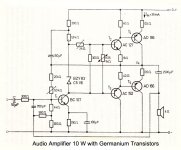 5C9ADE5F-DFFA-4E39-ABA1-FBC0BFE329B5.JPG139.4 KB · Views: 646
5C9ADE5F-DFFA-4E39-ABA1-FBC0BFE329B5.JPG139.4 KB · Views: 646 -
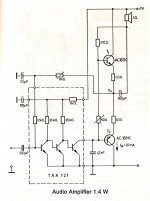 DF566719-1395-496A-87A9-06D101291350.JPG125.3 KB · Views: 658
DF566719-1395-496A-87A9-06D101291350.JPG125.3 KB · Views: 658 -
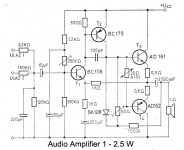 2C6607D6-18E0-43B1-A982-D48302E41968.JPG84.5 KB · Views: 705
2C6607D6-18E0-43B1-A982-D48302E41968.JPG84.5 KB · Views: 705 -
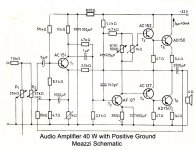 138EC19B-4AE6-4D35-8B4F-FD660225C9EF.JPG144.2 KB · Views: 344
138EC19B-4AE6-4D35-8B4F-FD660225C9EF.JPG144.2 KB · Views: 344 -
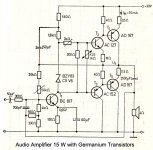 E8A11992-904C-4C28-8B3C-DF3605FDC60E.JPG122 KB · Views: 324
E8A11992-904C-4C28-8B3C-DF3605FDC60E.JPG122 KB · Views: 324 -
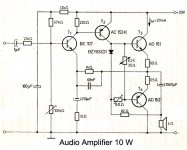 2F3737DC-F68F-4F6B-8064-F89A719448C4.JPG90.4 KB · Views: 315
2F3737DC-F68F-4F6B-8064-F89A719448C4.JPG90.4 KB · Views: 315 -
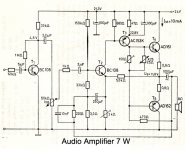 4B5BA26B-74C6-4B30-B6A5-A5C2A3A85AD0.JPG105.4 KB · Views: 306
4B5BA26B-74C6-4B30-B6A5-A5C2A3A85AD0.JPG105.4 KB · Views: 306 -
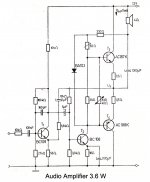 EC3DB2AD-D9B5-46E6-BBEC-03298847CE2C.JPG88.6 KB · Views: 326
EC3DB2AD-D9B5-46E6-BBEC-03298847CE2C.JPG88.6 KB · Views: 326
K25 was one enigmatic component  The answer is a thermistor.
The answer is a thermistor.
German company catalogue but writen in French
Siemens Semiconductors Edition 1968 1969 : Siemens : Free Download, Borrow, and Streaming : Internet Archive
 The answer is a thermistor.
The answer is a thermistor.German company catalogue but writen in French
Siemens Semiconductors Edition 1968 1969 : Siemens : Free Download, Borrow, and Streaming : Internet Archive
Attachments
No insight of any value, probably.
All of my germanium experiments centered around what I could get for free or real cheap as a teenage kid in the 60's. Most used the classic totem pole design that I showed in post #56. This required winding your own driver transformer, or buying one at the local Heathkit store. These designs were good in the day, but would be useful today only for a "period correct" amp.
I got a job at Motorola in late 1972. Silicon was free just by filling out a sample request form, so from 1973 on all my amps were silicon based, and again used the designs common in the 70's and early 80's. For a nearly 20 year period I built computer and ham radio stuff. Sound came from Phase Linear and Carver....until an old tube amp kicked that stuff into the closet. From the late 90's on most of my builds have been tube or hybrid designs.
I still have a few germanium small signal parts left, but they go into period correct (60's) guitar pedals.
I did spend a good deal of my career at Motorola learning about Statistical Process Controls. We made two way radios and cell phones, and went through the same manufacturing cultural changes as the semiconductor industry. We even had people living in and commuting to Japan to learn how they evolved technically.
@Tubelab:
I know they're not germanium but I recently acquired, in a big lot, around 150 Motorola M352 2N5190's. Any chance you know of a circuit or two these would be good to experiment with building?
Jeffrey
Last edited:
- Home
- Amplifiers
- Pass Labs
- Germanium investigations
